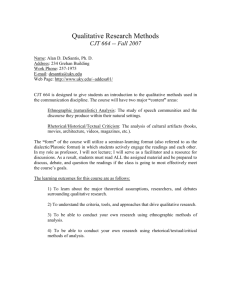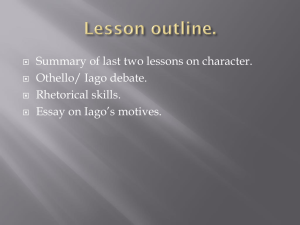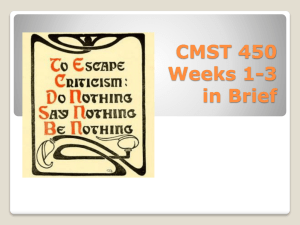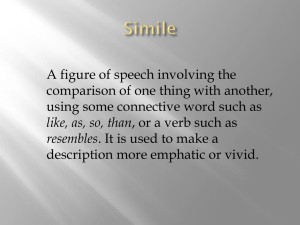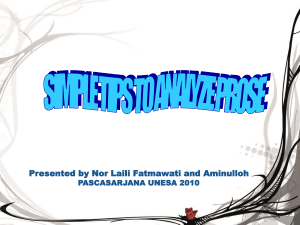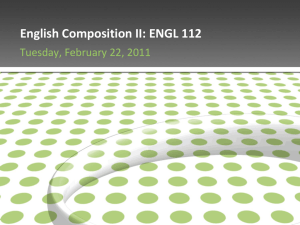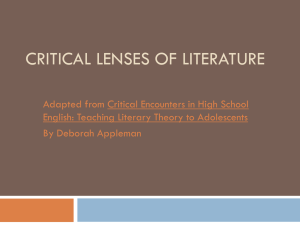Metaphor - chantrill.net
advertisement
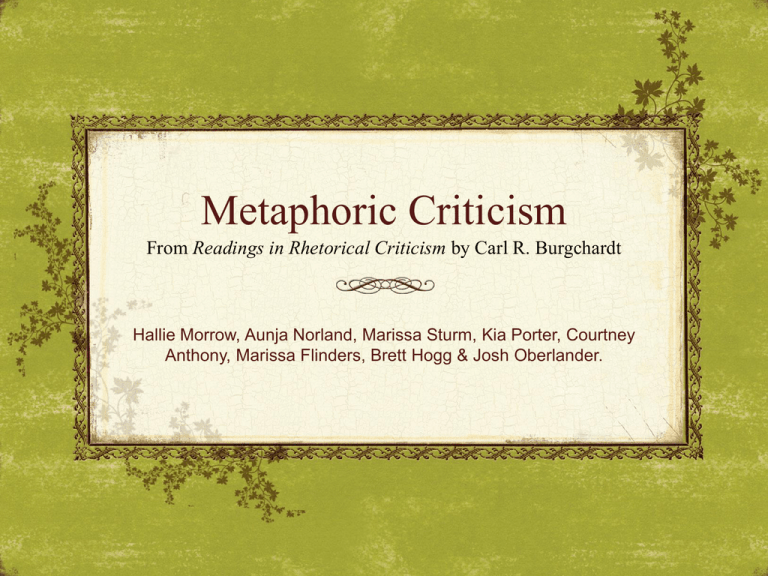
Metaphoric Criticism From Readings in Rhetorical Criticism by Carl R. Burgchardt Hallie Morrow, Aunja Norland, Marissa Sturm, Kia Porter, Courtney Anthony, Marissa Flinders, Brett Hogg & Josh Oberlander. Metaphor: “A figure of speech in which a word or phrase is applied to an object or action to which it is not literally applicable.” – Wikipedia Criticism: Metaphors are more than superficial ornamentation: they are means by which arguments are expressed, provide insight into a speaker’s motives or an audience’s social reality, affecting audience member’s junctures in speech. (Readings in Rhetorical Criticism, pg. 347) What is Metaphoric Criticism? • “Metaphoric criticism is not a unified method rather, it is a perspective that places metaphors at the heart of rhetorical action.” (Readings in Rhetorical Criticism, pg. 347) • “The metaphoric critic focuses on describing, evaluating, and understanding such metaphors as vital rhetorical phenomena. The articles in this chapter illustrate some of the diverse approaches a metaphoric critic must employ.” (Readings in Rhetorical Criticism, pg. 347) Osborn’s Archetypal Metaphors 1. Light and dark: “When speakers wish to place figurative value judgments upon subjects, they will more often prefer a light or darkness association over an association over an association Cadillac or Edsel, ivy or poison ivy, touchdown or fumble, etc.” 2. Cross-culturally: Behavior appears unaffected by cultural variation. Ex: God-blindly bright, Hades-gloomy darkness. 3. Prominent features of experience: in objects, actions, or conditions which are inescapably salient in human consciousness. 4. Contingent upon its embodiment of basic human motivations; Ex: man’s quest for power, symbolic expressions. 5. Double association: Features of experience with basic human motivations (i.e. certain experiences or emotions you go through determines the motivation and energy within audience). 6. Prominence in rhetoric: Tendency to occupy important positions within speeches, and their especial significance within the most significant speeches of a story. Archetypal Metaphors: 1. 2. 3. 4. Light and darkness. The sun. Heat and cold. The cycle of the seasons Light Dark Day Night Condition for sight Fear of unknown With light and sight: Informed environment, escape dangers, take advantage of rewards, exert influence over nature. Discouraging of sight Warmth/physical development Ignorant of environment Vulnerable/no control Cold (no development) The Sun • • • • Symbolizes human character Suggests qualities of goodness in man. More personal than light/ darkness. Different moments of the day have different significance Day cycle = life cycle Sun light is preferred over mad-made light Heat & Cold Fire: • Warmth = bodily comfort. • Growth of the body and its food/preparation of food. • Motivation. • Destructive. • Purifying (construction). • Birth of an idea and spread of ideas. • Youth and regeneration. Cycle of the Seasons • Variations in light/dark from one season to the next. • Extreme variations of heat and cold. • Hope/Despair. • Fruition/Decay. • Not as popular in rhetoric. Questions to ask Metaphoric Criticism • Invention: What characterizes a speaker’s selection of items for association? • Organization: How significant is the position of an image within a speech? • Ethical Proof: Does the metaphor give the reader an easy choice between good and evil? • Motive: What particular motive does a specific image emphasize? • Logical Proof: Does an image serve to reinforce a logical structure? Identifying Key Metaphors • Metaphor is the base of Rhetorical Invention • Elaborating a primary image into a well formed argument produces a motive or interpretation of reality with the intended audience who is invited to identify. • Examples of important uses of metaphor: I. Vehicle as a tenor Importance of metaphors • Metaphors are routinely elaborated into motivating perspectives • Value of locating metaphors: Speakers lose sight of alternatives when they become accustomed to routine extensions of images no longer their original purpose. Five Basic Steps that Provide Rudimentary Procedure for Identifying Key Metaphors 1. 2. 3. 4. 5. Familiarizing one’s self with the speaker’s text and context is essential to interpreting any particular selection of his or her disclosure. Representative texts are selected for a series of close readings undertaken to identify and mark vehicles employed by their speaker. Arrange the complete set of marked vehicles into subgroups by clustering those with similar entailment. A separate file of vehicles and their immediate contexts is compiled for each cluster of terms, i.e. one file for every metaphorical concept. The concept files compiled in step four are analyzed one by one for patterns of usage within and between clusters, thereby revealing the speakers system of metaphorical concepts. Michael Butterworth Democracy through the Iraqi National Soccer Team • Sports and Politics “Sport is the human activity closest to war that isn’t lethal” – Ronald Reagan Lethal: sufficient to cause death. Ron cook states, “Sporting events should be about competition, not politics”. In this section the biggest metaphor is about how the U.S. connects sports as politics as one against Iraq. This section is also a critique toward “the relationship between Bush’s broader rhetorical efforts and the 2004 Olympics, not only for what it reveals about politics, but for what I tells us about sport” (Readings in Rhetorical Criticism, pg. 378) Michael Butterworth Democracy through the Iraqi National Soccer Team • Global Game “The Olympic Games are the world’s largest and most recognizable international sporting event. The global nature of the Olympics, in fact, makes them an ideal vehicle for political posturing.” (Readings in Rhetorical Criticism, pg. 379) Within each country sports are a culture. For the U.S. the sport is football in Latin America, Africa and Middle East the sport is soccer. “Rowe suggests, because international sport depends on the production of national cultural differences, it may be constitutionally unsuited to carriage of the project of globalization in the fullest sense” (Readings in Rhetorical Criticism, pg. 380) Michael Butterworth Democracy through the Iraqi National Soccer Team • Co-Opting the People’s Game “If global sport is primarily American in character, then it may seem surprising that soccer plays an important role in shaping this image” (Readings in Rhetorical Criticism, pg. 382) “[American] football is democratic, capitalism, whereas soccer is a European socialist [sport]” (Readings in Rhetorical Criticism, pg.382) When the Iraqi team won the Olympics in 2004 the Bush campaign aired a commercial that stated, “Freedom is spreading through the world like a sunrise.” Bush conception of democracy was reflected both at home and around the world. Michael Butterworth Democracy through the Iraqi National Soccer Team • Politicizing the Pitch President Bush made clear that his democratic vision had been shaped by the terrorist attacks of 2001, and the subsequent “war on terrorism.” I’m a war president “…This is a world that Bush has neatly conveniently divided into good and evil.” (Readings in Rhetorical Criticism, pg. 383) The president defined was at the 2002 State of the Union address, “We’ve come to know truths that we will never question: evil is real, and it must be opposed…Deep in America character, there is honor, and it is stronger than cynicism. And many have discovered again that even in tragedy—especially in tragedy– God is near.” (Readings in Rhetorical Criticism, pg. 384) Fin.


